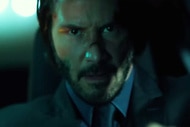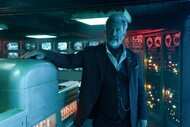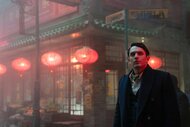Where Is The Continental? How John Wick's Assassin-Friendly Hotel Fits into Real-Life New York City
Let's learn some more about the origins of the killer-friendly hotel at the center of the John Wick universe.
Have you checked in yet? All three episodes of The Continental: From the World of John Wick, the first spinoff project to come out of the John Wick franchise, are now streaming on Peacock!
The limited series developed by Greg Coolidge, Kirk Ward, and Shawn Simmons turns back the clock to the late 1970s when a young Winston Scott (Colin Woodell) wrested control of the killer-friendly establishment from the hands of its former manager, Cormac (Mel Gibson).
It's easy to understand the allure of the titular hotel and the authority that comes with running it. After all, this prime piece of real estate in the heart of Manhattan's Financial District is the only place in New York where unscrupulous assassins can go without fear of receiving a bullet to the back of the head. The person who oversees The Continental's day-to-day operations literally holds the power of life and death in their hands.
For More on The Continental:
Why Do We Never See the Full High Table in the John Wick Franchise? Blame Austin Powers, Baby!
From Needle Drops to Background Beats: How Sound Helped Build the 1970s World of The Continental
The Continental: From the World of John Wick Director Breaks Down Finale's Most Creative Fight Scene
Where Is The Continental Hotel in John Wick?
Exclusively chatting with NBC Insider over a joint Zoom session prior to the series release, Dan Leigh and Nicholas Bernstein — the production designer and location manager on the original John Wick film — confirm The Continental's address as 1 Wall Street. The facade is that of the Cocoa Exchange building, which was designed by the Clinton & Russell architectural firm and erected in the early 1900s.
"Sometimes, people refer to it as the ‘Small Flatiron Building,'" Leigh explains. "The Flatiron Building is an iconic element of New York that a lot of people recognize. Not as much as the Empire State Building, of course, but a lot of people do recognize the Flatiron Building. So giving us the opportunity to have something that had that kind of familiarity to an audience was a bonus."
"It was so unique and so cool and so different," Bernstein adds. "We just realized it was the perfect place."
To amp up the magisterial nature of the location, Leigh added several distinctive markers to the outside like an awning (complete with the hotel's capital 'C' logo) and two row of light sconces on ether side of the structure. "The awning — because of its oddity and its shape and scale and everything — became an important visual element," he says. "So without the awning, I don't know if people really go, 'Oh, wait! That’s from John Wick!’"
Funny enough, when Leigh and his wife considered moving to a new apartment in the city several years back, they discovered units available in that very building. What's more: "the real estate listing was using the John Wick location as a bonus" to attract prospective tenants, the production designer remembers.
Had John Wick not been allowed to shoot outside of Cocoa Exchange, Leigh had a back-up in the same area: an empty, bank-owned building adjacent to the New York Stock Exchange. "It was a very classic New York exterior," he notes. "It was quite beautiful and had some really nice carving in the stone."
Bernstein chimes in that the location would have been tricky to shoot from a cinematography standpoint. "You couldn't pull back as much," says the location manager. Leigh echoes the sentiment: "You couldn’t. You wouldn't be able to get the wide shot. Him pulling up, going in, and all of that would not have been nearly as interesting. And the awning would have been very short."
More importantly, the building's adjacency to the NYSE would have made it incredibly difficult to secure filming permits due to stricter safety measures adopted in the years following 9/11, Bernstein adds.
John Wick's Continental Lobby Was Housed Inside a New York City Landmark
Since the ground floor of the Cocoa Exchange was home to several businesses (the entryway seen in the film actually led into a Chinese restaurant), Leigh and Bernstein had to find a different place for The Continental lobby.
The scenes involving The Continental's foyer were filmed several blocks away in the chapel-like interior found at 25 Broadway. One of the few interiors designated as a historical landmark by New York, this Italian neo-renaissance marvel was once the waiting area for the Cunard ship line. "If you were going on a Cunard cruise across the Atlantic to Europe from New York, this is where you brought your luggage, got your tickets, and waited. Then you were taken on board the ship," Leigh explains.
Bernstein stresses that 25 Broadway's close proximity to the hotel exterior was of the utmost importance, "because there was a lot of work on both and it probably would not have been feasible to have done it if they were in really distant locations around the city."
Given 25 Broadway's landmark status, however, Leigh wasn't permitted to make serious alterations to the space. The ceiling's light fixtures in particular were "very dated and stodgy and not really part of our movie," he emphasizes. "So, right away, I knew that I wanted to drape them in chainmail to give them a contemporary feel."
There were also "other revolving doors that came into that space, which needed to be hidden," the production designer continues. His workaround came in the form of "these marble panels that were backlit with these round fireplaces."
A third location, a hotel in Midtown (neither Leigh nor Bernstein can remember the name at the time of our call), served as The Continental "speakeasy" where we first meet Winston, Leigh says.
A local soundstage, where Leigh built the hotel room sets, completed the movie magic puzzle. Going off the assassins' centralized currency of gold coins, the production designer knew he wanted the lodgings to be "pretty luxe."
"With my set decorator, Susan Bode, we really put a lot of focus into making sure that that room was really as high-end as possible. There’s the gold domes on the ceilings and a lot of glass. A lot of the glass was there for bullet hits."
In addition, the hotel rooms are about the only welcoming places featured throughout the film. After discussing the overall look of the project with directors Chad Stahelski and David Leitch, Leigh adopted an ethos of "unfriendly spaces" full of "hard edges."
"There weren’t very many places in John Wick where you felt like he would want to be, except maybe his hotel room, which was the point," he says. "Everything else was pretty uncomfortable."
An Alternate Version of John Wick's The Continental Hotel
According to Leigh, one of the directors originally wanted a "pop culture hotel" atmosphere for The Continental.
When we ask him to elaborate on what that would have looked like, the production designer paints the mental picture of a lobby-less entrance flanked by "two very long escalators going up with neon on both sides of the escalators. And then when you actually got up to the top, there was this very kind of glitzy, neon-lit lobby."
While he concedes this was intriguing from a visual standpoint, he ultimately decided (and rightly so) that it would slow down the main character's arrival. "If Keanu pulled up, got out of his car and went in, then you're gonna have all of this time of somebody on an escalator to get to the lobby." The proposed location was also a working hotel and Leigh "knew that with our budget category, they would never agree to shutting down the lobby ... so that we could film [there]."
Arguing that the "pop culture" route would truncate the film's cultural "longevity," Leigh talked the directors out of the idea and into a "classic New York" aesthetic. "I was very much trying to point them towards locations that Nick and I knew about that would be able to pull together to make a very classic, very weighty hotel environment. And eventually, they both came around to that."
The Future of the John Wick Franchise
In addition to The Continental, Lionsgate has a second spinoff waiting in the chamber — next summer's Ballerina — which takes place between the events of Chapters 3 and 4. Helmed by Len Wiseman (director of Underworld and Underworld: Evolution), the film stars Ana de Armas as a deadly member of the Ruska Roma crime family, to which John also belongs.
Keanu Reeves will make a cameo appearance alongside fellow Wick mainstays Ian McShane (Winston) and the late Lance Reddick (Charon). Newcomers to the franchise include Gabriel Byrne, Norman Reedus, and Catalina Sandino Moreno.
While a fifth installment in the main John Wick series remains up in the air at the moment, the studio hopes to keep the property going indefinitely within the spaces of film, television, and video games.
"It never felt like this was going to become a franchise," Leigh admits. "It felt like this was an interesting graphic novel kind of parable about this guy and revenge and that that would pretty much be it. So the fact that it's had the legs that it's had is still amazing to me."
Bernstein goes on to credit the longevity of the Wick brand to the simple fact that the 2014 original didn't have the time or budget of its three successors. "I think it sharpened everyone's creative energies slowly. It’s why the look of that movie became so cool and then birthed these other films," he says.
That lack of money meant the crew was "bound by reality," Leigh concludes. "John Wick 1 has great gravitas in the story and its environments. It’s very much done in a very realistic way. There is very little in John Wick 1 that’s fantasy. And certainly, our approach was never that we were doing fantasy at all. But I must say that when you get to John Wick 2, 3, 4, and 18, you are really going into a fantasy world there. And I think that's the big difference between 1 and the other John Wicks."
How to Watch The Continental: From the World of John Wick
All three episodes of The Continental: From the World of John Wick are now streaming on Peacock. Need even more High Table action? John Wick Chapters 1-3 are also streaming!
Peacock currently offers two monthly subscription plans: Premium ($5.99 a month with ads) and Premium Plus ($11.99 a month with no ads and download access for certain titles). If you're currently a student, you can enjoy the Premium plan for just $1.99 for an entire year.
Originally published Sep 18, 2023.
































